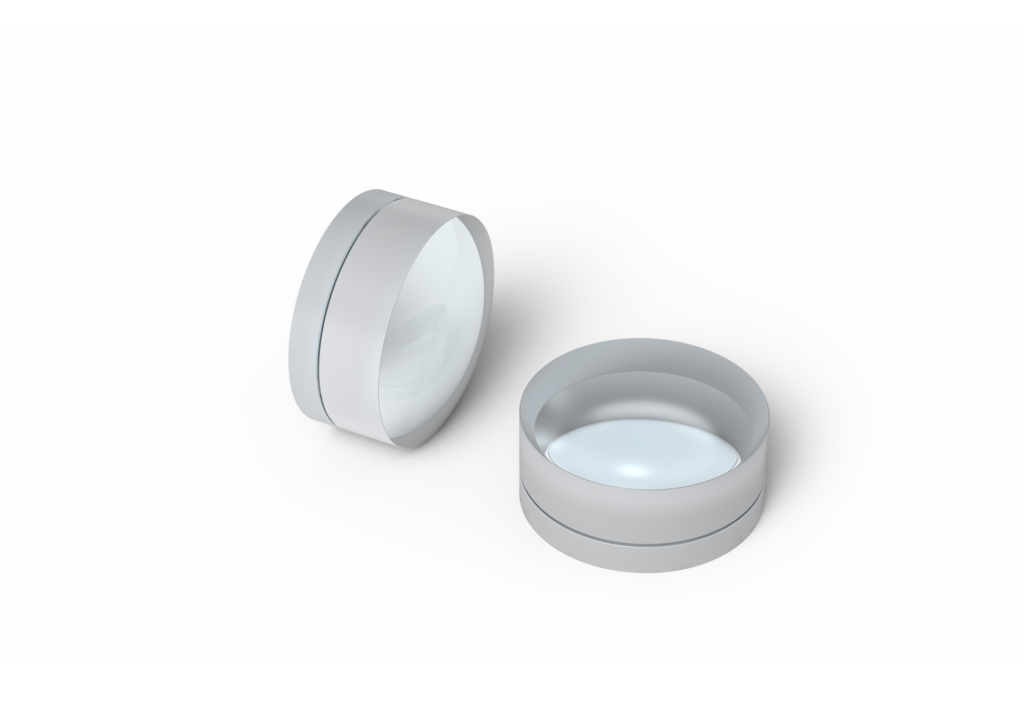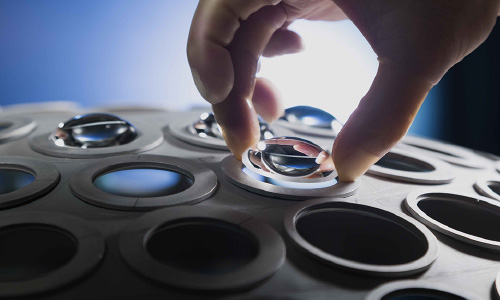
A lens is made by grinding a transparent material such as glass into a circular sheet so that both surfaces are curved or one side is flat. Its function is to make the light beam converge or diverge through the refraction of its two surfaces, and form the image of the object at any required position.
Double glue lens is a lens obtained by gluing two lenses together. The combined lens formed by two lenses is an effective method to obtain short focal length, large magnification and better imaging quality. It has been widely used in astronomical telescopes and cameras.
Background introduction of double glued achromatic lenses
Optical microscopy is an ancient subject that has been studied for more than a century to observe the micro world. The non-destructive nature of optical microscopy is important for various fields, such as the research of biology and material science. The main disadvantage of ordinary optical microscope is that the resolution is limited by the diffraction limit, and its resolution is an order of magnitude with the illumination wavelength; Another limitation is its limited focal depth. These limitations make it difficult to image objects with a certain thickness using ordinary optical microscopy, so three-dimensional (3D) imaging of thick samples is impossible.
In order to improve the optical resolution, many kinds of optical filters with 3-D confocal lens are proposed to improve the optical resolution of ordinary pupil imaging systems. Such as ring with central occlusion, light leakage ring pupil, phase pupil and grating, etc. These pupils improve the resolution of 2-D imaging, but due to the extension of the focal depth in the axial direction, it is not suitable for confocal 3-D imaging. In addition, due to the method of adding pupil to the lens, the intensity of the light spot is reduced, some even more than 90%, which greatly reduces the signal-to-noise ratio of the optical system.
The combined lens formed by two lenses is an effective method to obtain short focal length, large magnification and better imaging quality. This method has been widely used in astronomical telescopes and cameras. In 1990, Mansfield et al. Applied two separate lenses (they are called solid immersion lenses) to near-field light storage, and proved that placing a hemispherical solid immersion lens on the imaging surface of the lens can improve the transverse resolution of the microscope by N times (n is the refractive index of the solid immersion lens). Recently, many literatures have further studied the lateral resolution and polarization characteristics of solid immersion lens, and some literatures use two separate lenses to obtain high numerical aperture lens to improve the resolution of optical system,. The diffraction imaging characteristics of two closely glued double glued thin lenses are analyzed by scalar diffraction theory. It is found that it has not only better transverse resolution, but also higher axial resolution. It can be used as an ideal optical element for confocal 3-D imaging.
lens
A lens is made by grinding a transparent material such as glass into a circular sheet so that both surfaces are curved or one side is flat. Its function is to make the light beam converge or diverge through the refraction of its two surfaces, and form the image of the object at any required position.
There are many kinds of lenses. The most commonly used is spherical lens, that is, a lens formed by two spherical surfaces or one surface is spherical and the other surface is plane. It can be divided into convex lens and concave lens.
Convex lens is also called positive lens, and its central part is thicker than the edge. According to their section shape. It can also be divided into biconvex, Plano convex and lunar convex. Because convex lens has convergence effect on light beam, it is also called convergent lens.
Concave lens is also called negative lens. Its central part is thinner than the edge part. According to its cross-sectional shape, it can be divided into double concave, flat concave or lunar concave. Because concave lens has divergent effect on light, it is also called divergent lens.
To study the lens, we must first understand the following concepts: (1) main optical axis. The straight line passing through the curvature centers of the two spherical surfaces of the lens is referred to as the principal axis for short. (2) Optical center. A certain point on the main axis. The direction of the light when it is emitted from the lens is parallel to that when it is emitted into the lens, but there is a lateral shift. It can be proved that the distance between the optical center of the lens and its two spherical curvature centers is directly proportional to the two curvature radii. Therefore, only when the curvature radii are equal, the optical center and the lens center coincide. Generally, the position of the optical center is different due to the different curvature radii of the two spherical surfaces, and the optical center is not necessarily inside the lens. (3) Countershaft. That is, except for the main axis, other straight lines passing through the optical center are called secondary axes. If the thickness of the lens is much smaller than the radius of curvature of the two spheres, it is called a thin lens. This entry only discusses thin lenses. (4) Focus. The intersection of the incident beams parallel to the main optical axis after refraction by the lens or the intersection of the reverse extension line is called the main focus of the lens. The former is called the real focus and the latter is called the virtual focus, which is usually represented by F. according to the space where the focus is located, the focus of the object space is called the object focus, also known as the first focus, which is represented by F1; The focus of the image space is called the image focus, also known as the second focus, which is represented by F2. F1 and F2 are separated on both sides of the lens. (5) Focal length. That is, the distance from the center of the thin lens (i.e. optical center) to the focus. The first focal length is represented by F1 and the second focal length is represented by F2. For thin biconvex or biconvex lenses, F1 = F2, so generally only f represents the focal length. (6) Focal plane, that is, the plane passing through the main focus of the lens and perpendicular to the main optical axis. (7) Secondary focus. That is, the light parallel to the sub optical axis with a small angle with the main optical axis converges or diverges after being refracted by the lens, and the reverse extension line of the light converges at a point on the sub axis, and the sub focus is on the focal plane.
A thin lens can make an object image. The distance between the object and the lens (object distance) is different, and the nature of the image (real, virtual, positive and inverted, on the same side or different side of the mirror, amplification and reduction, etc.) is different. The image of a known object can be obtained by graphic method and formula method.
Convex lens
Also known as aggregation lens, collective lens, plus lens, converging lens, point focus lens, condensers, focusing lens and plus lens. A lens whose central part is thicker than the edge part and has the function of aggregating light. The focal length of a convex lens is greater than zero. Expressed in (+). It can be divided into biconvex, flat convex and concave convex. The imaging principle is as follows: ① when the object is outside the focus and within the double focal length, it forms an inverted enlarged real image. ② When the object is at twice the focal length, it forms a large real image such as handstand. ③ When the object is outside the double focal length, it forms an inverted reduced real image. ④ If the object is in the focus, an upright enlarged virtual image is formed on the same side of the object.
A lens with a thick center and a thin edge. If the two refractive surfaces are coaxial spheres with the same radius, they are biconvex lenses. Can make the light converge. The paraxial parallel ray converges at a point on the principal axis after being refracted, which is called the main focus. Two main focal points are symmetrically distributed on both sides of the biconvex lens. The relationship between object distance (U), image distance (V) and focal length (f) and the formula of image linear magnification (m) are 1 / U + 1 / v = 1 / F and M = image length / object length = |v / u|. In addition to being used as the lens and magnifying glass of presbyopia glasses, convex lenses are also widely used in cameras, slide projectors, telescopes, collimators and microscopes. In the pre Qin period, China began to experience the spotlight and focus on the sun with natural transparency with appropriate shape. The ice lens was invented in the Western Han Dynasty. “Huainan Wanbi technique” wrote: “the ice will be round, lift it to the sun, take its shadow with AI, and the fire will grow.”. That is, cut a piece of ice into a ball, face the sun, and put a flammable object at its focus to catch fire.
Concave lens
Also known as diverging lens, diverging lens, diverging lens, beam splitting lens, zero converging lens, negative lens and minus lens. The part that diverges is thinner than the central part of the lens. The focal length of concave lens is less than zero, which is represented by (-). The light parallel to the main axis becomes divergent light after being bent by the concave lens. The backward extension line passes through a point on the main axis, that is, the virtual focus of the concave lens. Its focal length is negative, so ophthalmology is represented by a negative sign. The imaging principle is that when an object is placed in any position, it forms an upright and reduced virtual image after passing through the concave lens. It can be divided into double concave, flat concave and convex concave.
A lens with a thin center and a thick edge. If the two refractive surfaces are coaxial spheres with the same radius, they are biconcave lenses. It can spread light. The extension line of paraxial parallel light after refraction converges at a point on the main axis, which is called virtual focus. There are two symmetrical virtual focal points on both sides of the biconcave lens. The image of an object through a concave lens is always a reduced and upright virtual image on the same side of the object. The imaging law is the same as that of convex lens, that is, follow the formula 1 / U + 1 / v = 1 / F and M = image length / object length = |v / u| (V and F are negative values). In addition to being widely used as the lens of myopia glasses, concave lens often forms a composite lens with convex lens, which is widely used in various optical instruments. Ancient China has been able to make wonderful utensils with composite lenses. For example, in the butterfly cup made in Houma City, Shanxi Province in 1980, a convex lens is embedded in the center of the cup bottom, and a colored butterfly is installed outside the focus of the convex lens with a thin spring in the cup foot. When there is no wine (water) in the cup, the colored butterfly forms a real image on the same side of the human eye, which is blurred. After pouring wine (water), it forms a concave lens with the edge of the cup, and the latter forms a composite lens with a convex lens. Its focal length is long, so that the color butterfly is in the focus of the composite lens and forms an enlarged upright virtual image at the bright viewing distance. A little disturbance, butterflies that dance.
Design and numerical simulation of double glued achromatic lenses
In order to illustrate the resolution effect of double glued lens, the calculation comparison of this method with ring pupil and phase pupil is given. In the calculation, take N2 = 1.5, N3 = 2, N1 = N4 = 1, R1 = 1 m, R2 = – 1 m, R3 = – 0.5 m, a = 0.6 m, the central shielding radius or the inner ring radius of the ring beam ε= 0.65a。 Save the calculation results. I0 and RD in Table 1 represent the intensity and radius of the main lobe on the focal plane respectively, Δ F represents the focal depth of the main lobe on the axis, I’1 represents the intensity of the first side lobe on the axis, and I0 / I1 and I0 / I’1 represent the contrast of the focal plane and the main lobe on the axis respectively. The focal spot radius and focal depth obtained by this method are smaller than those obtained by the other two methods, and less than that of the bare lens (single lens), which shows that the double glued lens improves the resolution of a single lens in both transverse and longitudinal directions. On the beam waist plane, the ratio of the maximum light intensity of the main focal spot to the first side lobe (I0 / I1) is equal to 57.14, which is about 7.5 times that of the ring pupil or phase pupil, indicating that the imaging spot has high contrast at this time. In the axial direction, the ratio of the light intensity of the focus to the light intensity of the first sub focus (I0 / I’1) is basically the same as that of the other two methods. It can also be calculated that the maximum light intensity of the main focal spot is 5.13 times of the phase pupil, 6.75 times of the ring pupil, and even 2.25 times larger than that of the bare lens. That is to say, the double glued lens system has a large SNR (signal-to-noise ratio).
End





